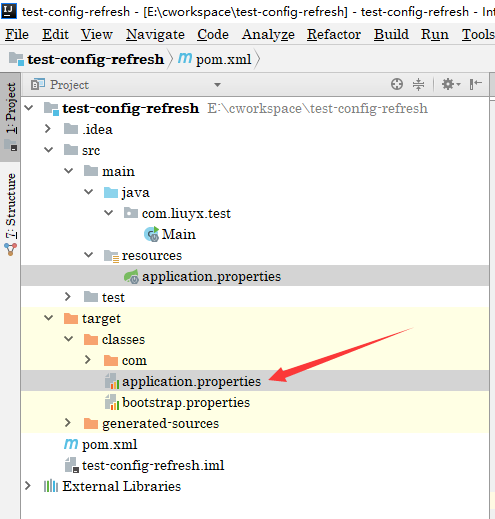spring boot 配置动态刷新
本文测试使用的spring cloud版本为:
Dalston.SR1
很多朋友只知道spring cloud config可以刷新远程git的配置到内存中,
却不知道spring cloud config的客户端可以脱离服务端使用,
更不知道spring cloud config客户端结合actuator还可以刷新本地的配置文件到内存中。
具体做法如下:
1、pom:
<?xml version="1.0" encoding="UTF-8"?> <project xmlns="http://maven.apache.org/POM/4.0.0" xmlns:xsi="http://www.w3.org/2001/XMLSchema-instance" xsi:schemaLocation="http://maven.apache.org/POM/4.0.0 http://maven.apache.org/xsd/maven-4.0.0.xsd"> <modelVersion>4.0.0</modelVersion> <groupId>com.liuyx</groupId> <artifactId>test-config-refresh</artifactId> <version>1.0-SNAPSHOT</version> <parent> <groupId>org.springframework.boot</groupId> <artifactId>spring-boot-starter-parent</artifactId> <version>1.5.4.RELEASE</version> <relativePath/> <!-- lookup parent from repository --> </parent> <dependencies> <dependency> <groupId>org.springframework.boot</groupId> <artifactId>spring-boot-starter-web</artifactId> </dependency> <dependency> <groupId>org.springframework.cloud</groupId> <artifactId>spring-cloud-starter-config</artifactId> </dependency> <!--监控+refresh配置--> <dependency> <groupId>org.springframework.boot</groupId> <artifactId>spring-boot-starter-actuator</artifactId> </dependency> </dependencies> <dependencyManagement> <dependencies> <dependency> <groupId>org.springframework.cloud</groupId> <artifactId>spring-cloud-dependencies</artifactId> <version>Dalston.SR1</version> <type>pom</type> <scope>import</scope> </dependency> </dependencies> </dependencyManagement> </project>
单独引入 spring-boot-starter-actuator或者spring-cloud-starter-config(spring cloud config的客户端) 是不会暴露/refresh端点的,两者同时引入之后才能暴露/refresh端点。
2、一般使用spring-cloud-starter-config的文章都会让你在bootstrap里加上配置中心服务端的地址,这里我们要脱离配置中心服务端使用,所以这些配置完全不需要。
3、对需要刷新的属性使用@Value注解,同时将类使用@RefreshScope注解进行标记,示例如下:
package com.liuyx.test; import org.springframework.beans.factory.annotation.Value; import org.springframework.boot.SpringApplication; import org.springframework.boot.autoconfigure.SpringBootApplication; import org.springframework.cloud.context.config.annotation.RefreshScope; import org.springframework.web.bind.annotation.RequestMapping; import org.springframework.web.bind.annotation.RestController; @SpringBootApplication @RestController @RefreshScope public class Main { public static void main(String[] args) { SpringApplication.run(Main.class); } private static int port; @Value("${server.port}") public void setPort(int port){ this.port=port; } @RequestMapping("/port") public int port(){ return port; } }
这里我的变量是一个static变量,所以只能在非static的set方法上加@Value注解,而不是变量定义行的上方。如果不是静态变量则可以直接写作:
@Value("${server.port}")
private int port;
4、application.properties配置
server.port=80 local.test=hello1 management.security.enabled=false
5、测试
1、启动项目,访问 http://localhost/port 显示 80
2、修改classpath(注意是classpath,即你编译后的class文件所处的目录)下的application.properties将server.port改为801

3、发送空post(注意是post)请求到 http://localhost:80/refresh

4、再次访问 http://localhost/port 显示 801 测试成功
最后的补充:
即使结合配置中心服务端使用,该方法也是有效的,所有有效位置的有效配置文件(如git上的,jar内的,jar外的)都会被扫描,并根据一定的顺序进行覆盖,覆盖顺序传送门
(完毕)


 浙公网安备 33010602011771号
浙公网安备 33010602011771号